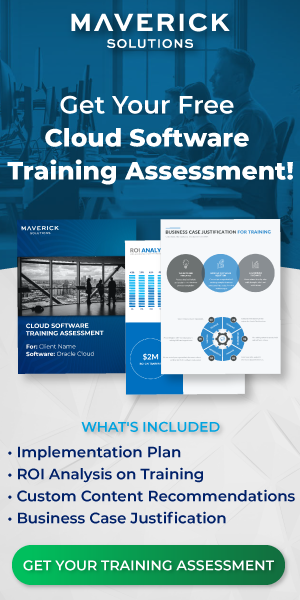Simply put, you use the Manage Invoice Methods task! In reality, the process is a little more involved than just finding the right configuration task. Read on to understand the four invoice method classifications and how to create invoice methods in Oracle Cloud.
Step 1: Navigate to Setup and Maintenance
In order to access the Manage Invoice Methods task, you will need to access Setup and Maintenance. There are three main ways you can get to setup and Maintenance:
- From the tabs on the homepage, select Others > Setup and Maintenance.
- Select the drop-down arrow next to your username and select Setup and Maintenance from the drop-down list.
- Select the Navigator icon, then select Others > Setup and Maintenance.
Step 2: Navigate to the Manage Invoice Methods task
Method 1: Use the Functional Setup Manager (FSM) in the Setup and Maintenance work area.
- You will need to use the setup drop-down list to change the offering to Project Financial Management. The default offering in the FSM is Compensation Management.
- Once you have changed the offering, select the Project Billing Base row in the Functional Areas section.
- Select the Manage Invoice Methods task. This is a required task.
Method 2: Use the Search Tasks field to search for the Manage Invoice Methods task.
Note: If you try to use the Search Tasks field prior to changing the offering from Compensation Management to Project Financial Management, you will receive an error.
Method 3: Use the Tasks pane to search for the Manage Invoice Methods task.
Note: If you use the Search link in the Tasks pane, you will not have to change the offering in the FSM.
Step 3: View the Manage Invoice Methods page
Selecting the Manage Invoice Methods link tasks you to the Manage Invoice Methods page. This page will include all the currently existing invoice methods. There are seven seeded invoice methods that cannot be deleted. Seeded data is data defined by Oracle.
From this page, you can create invoice methods in Oracle Cloud. Or you can edit or delete invoice methods. You also have the option to export the data to Microsoft Excel or filter the invoice methods.
Step 4: Create invoice methods in Oracle Cloud
To create invoice methods in Oracle Cloud, simply select the Create icon (plus sign) on the Manage Invoice Methods page. This will open the Create Invoice Method page.From here, you can create invoice methods in Oracle Cloud according to your company’s needs.
Things to consider as you create invoice methods in Oracle Cloud
There are several parts to consider as you create invoice methods in Oracle Cloud. The two easiest are the Name and Status fields.
Name field
When you create invoice methods in Oracle Cloud, you can type in any string of characters desired into the Name field, this allows you to identify the process later.
Status field
There are two statuses you can use as you create invoice methods in Oracle Cloud: Active and Inactive. An Active status means the invoice method can be used in the project portfolio management tasks, an Inactive status will prevent the method from appearing in drop down lists in the main User Interface for use.As you create invoice methods in Oracle Cloud, you will need to decide if this invoice method will be used for intercompany billing. Intercompany billing shares revenue from internal invoices and accounting entries across organizations by creating invoices from intercompany billing contracts .
Say you own a company named ABCD. Company ABCD owns both the manufacturing company that makes the products and the retail stores that sell the products. While company ABCD ends up with all the profit, when the retail stores receive products to sell from the manufacturer, an intercompany invoice is created to track the movement. Depending on how the companies are setup, money may even be exchanged between general ledgers to track which financial assets lie with which company at any given time.
If you would like your invoice method you are creating to be used in situations like the one described where an internal invoice is created, then you should select the Use Invoice Method for Intercompany Billing checkbox.
What’s next? Selecting an Invoice Method Classification.
You can use one of the four different invoice method classifications as you create invoice methods in Oracle Cloud:
- Amount Based
- Percent Complete
- Percent Spent
- Rate Based
Let’s talk about each one and when you would choose each option.
Amount Based
When you create invoice methods in Oracle Cloud that are classified as Amount Based, the application will generate the invoice at the completion of a billing event. An amount- based invoice would be used for transactions involving physical goods. Someone ordered 50 computers, you sent 50 computers, an amount was paid to you, and the transaction is complete. If your company mainly using cash accounting, then the invoices will be amount-based.
When you select Amount Based as the Invoice Method classification, you have the option to add Billing Extension Assignments. The options for Billing Extensions for an Amount Based Invoice are Percent Current Invoice Fee and Percent ITD Invoice Fee. As the names imply, choosing one of these extensions will add an Invoice fee to every invoice generated using this method. A Percent Current Invoice Fee will add a flat-rate fee while the Percent ITD Invoice Fee will add either a rate-based fee or a percent-based fee on the Inception to Date invoiced amount minus any previously billed amounts.The other three options function on variations of accrual accounting, a method of revenue recognition that recognizes revenue over time rather than at the beginning or end of a transaction.
Percent Complete
A Percent Complete invoice creates billing based on estimation of progress towards contract completion. This estimation is created based on the number of days the project is supposed to take and the number of days that have passed. You can tell Oracle to calculate progress for a single contract line or for an entire task and project. For example, you have a project to build a new building. Instead of paying the contractor all the money at the beginning or end of the project, you divide the amount of money owed over the period of time the work is being completed and invoice it a little bit of a time. Say you decided in the contract to pay them half of the amount when the work was 50% complete (with the assumption that the work is half done when they are halfway between starting and ending the project), and the other half when the work was 100% complete. This would use a percent complete invoice method. You are basing the amount owed based on the work done.
When you select Percent Complete as the Invoice Method classification, you have the option to add Billing Extension Assignments. The Percent Complete billing extension will automatically be assigned. This enables the calculations to be done per contract line. You can also add four other billing extensions. We’ve already discussed two of the options: Percent Current Invoice Fee and Percent ITD Invoice Fee. The other two options are Percent Spent Invoice and Process Configurator Invoice. The percent spent invoice option will calculate billing events using the percent spent method (discussed in the next section) and the process configurator invoice method calculates accrued predicted loss.
Percent Spent
Percent Spent is very similar to percent complete except instead of using work complete to estimate project progress, Oracle uses amount already spent to calculate how complete the project is. So say you gave a project team $10,000 to complete a project and in return they will create a product for you worth $100,000,000. When the team has spent $5,000, it would be assumed the project is halfway complete and an invoice would be created for $50,000,000 (assuming no other invoices have been made previously). Oracle can calculate progress for a single contract line or for an entire task and project.
Say you have 5 days to do a project but only work on the project for the last two days. If that’s the case, then at 2.5 days in, 0% of the work has been done even though half of the project period has passed. A company may choose to invoice you using the percent spent method in this instance rather than the percent complete method, so they are paying for work done rather than work expected.
When you select Percent Spent as the Invoice Method classification, you have the option to add Billing Extension Assignments. The Percent Spent billing extension will automatically be assigned. This enables the calculations to be done per contract line. You can also add any of the other billing extension assignments already discussed.
Rate Based
A rate based invoice will generate an invoice as a cost is incurred. Oracle knows when a cost has been incurred based on a defined set of bill rates, a burden schedule, or transfer price rates. An invoice is sent out when a company wishes to collect money from another entity so to create an invoice as a cost is incurred may come across as counter-intuitive. A better way to think about this is you have hired out a consultant and they charge $400/day and you are paid for their service once/week. So once a week you send out a rate-based invoice for $400/day times 5 days. This type of invoice method differs from amount based invoices because you are charging a rate and not a fixed price.
When you select the Rate Based invoice method you have to select both a Labor Schedule Type and a Nonlabor Schedule Type. The options for both types are Bill Rate, Burden, or Cost reimbursable. You do not have to select the same type for both categories. You could select Bill Rate as the Labor Schedule Type and Burden as the Nonlabor Schedule Type.
You can also add Billing Extension Assignments to the Rate Based Invoice method, specifically either the Percent Current Invoice Fee and Percent ITD Invoice Fee assignment options.
For all four classification methods, the billing extension assignments can be active or inactive separately of the active or inactive status of the invoice method itself.And that’s it!
That is everything you need to create invoice methods in Oracle Cloud. For a complete walkthrough of the process or to learn more about invoices in Oracle Project Portfolio Management, call one of our Oracle Cloud training experts today!



